Introducing the KanKouran West African Dance Company
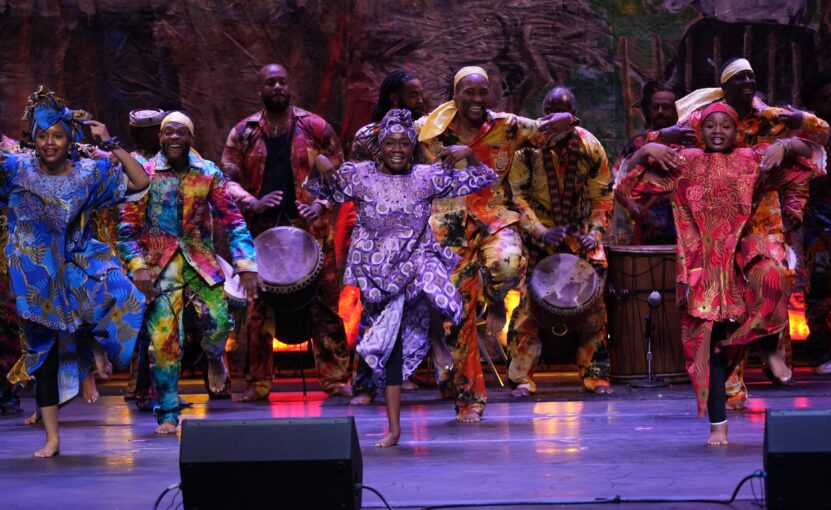
Niou bolo moye dolle (the power of coming together)
BY SOUMANOU SALIFOU
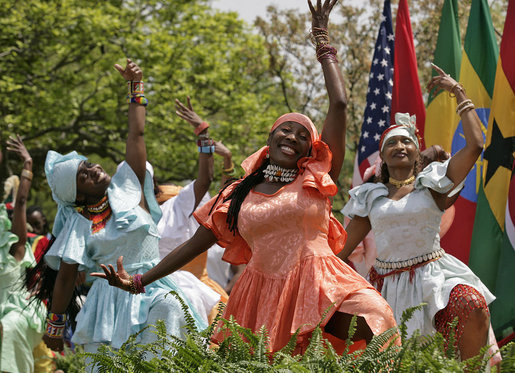
The White House, the Rose Garden, April 25, 2007—It’s a gorgeous spring day in the nation’s capital. Mother nature has inundated the lush, green lawn of the White House with bright sunshine. The president of the United States, flanked by the first lady, is hosting a ceremony marking Malaria Awareness Day, with a large crowd of distinguished national and international guests in attendance.
The president, George W. Bush, will go down in history as the initiator of the President’s Malaria Initiative (PMI) launched two years earlier, which will contribute a whopping $1.2 billion over five years to reduce malaria deaths by 50 percent in 15-target African countries. He will also be celebrated as the father of the President’s Emergency Plan for AIDS Relief (PEPFAR), initially a $15-billion program that will benefit mostly African nations, over a five-year period—the largest investment in history to fight a single disease.
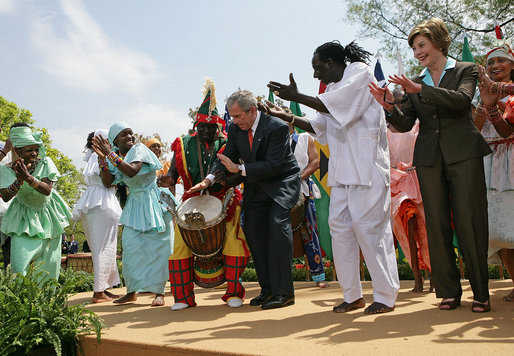
On that same beautiful, sunny day of April 25, 2007, Mr. Bush will also go down in history as the first U.S. president—so far, the only one—to invite an African dance company, KanKouran, to perform at the White House. The Washington-based West African Dance Company, founded in 1983, used the occasion to showcase the power and grace of African dance before a visibly enchanted audience.
The show rose to another level when the president of the United States joined the African dancers on stage, beat the drum with them, danced with them, and sang with them. It was anyone’s guess the words that were coming out of the president’s mouth; his beats or dance moves may not have been in tune with the music; but was he fully African for one day!
Over the 24 years leading to April 25, 2007, KanKouran had captivated America with the colorful outfits of its dancers and the magical blend of dexterity and grace of their dance steps to the tune of a fast beat. But the company’s performance at the White House constituted, no doubt, a historical step in its journey.
The African is thrilled to introduce KanKouran, the preeminent African cultural ambassador to the United States, thanks to the much-appreciated support of the company’s co-founder and artistic director, Assane Konte, and executive director, Ali Rahmaan.
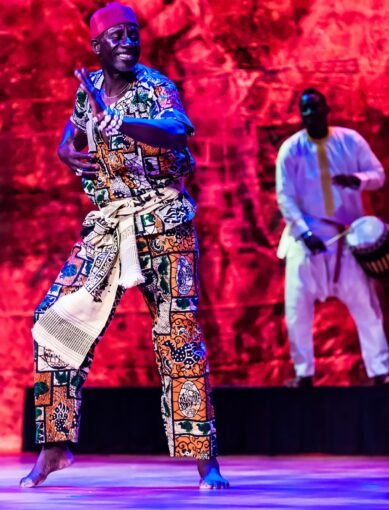
The idea of the Kankouran West African Dance Company crystalized in the minds of two pioneers, Assane Konte and Abdou Kounta, two friends who grew up together in their native country, Senegal, before going their separate ways. When arriving in Washington, D.C. in 1978, Assane had no idea his childhood friend, Abdou, whom he had not seen in thirty years, had been in the nation’s capital for one year. The disbelief gave way to excitement when the two young men reunited on the American soil. However, they had to go their different ways once again in the U.S., with Assane heading to San Diego to fulfil his contract. But he was later joined there by his friend Abdou to work with the ensemble he had put together.
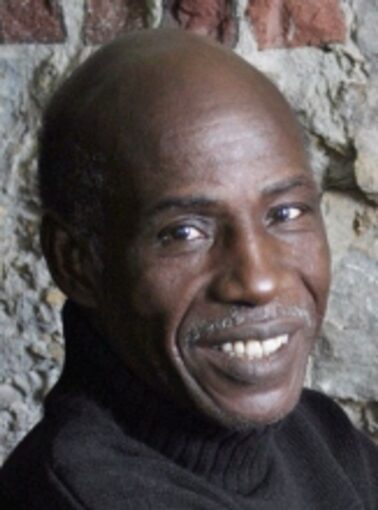
Fast forward: after working together in D.C. with then-legendary Melvin Deal’s African Heritage Dancers and Drummers for a while, the two artists decided to start their own company. The KanKouran West African Dance Company saw the light of day in 1983, with Abdou as its musical director and Assane as its artistic director. After many months of recruiting, training and performing at local venues, KanKouran presented its first full-length concert, “A Visit to Africa,” in 1985. With that performance, an institution was born.
KanKouran’s repertoire is a brilliant reflection of the excellence in artistry and performance that is so widely associated with the company. Over the years, the artistic and musical directors have met the great challenge of presenting traditional African celebrations and ceremonies in a Western performance context; communicating the rich and complex history and culture of West Africa with the technical prowess, energy and grace that entertains and moves audiences everywhere.
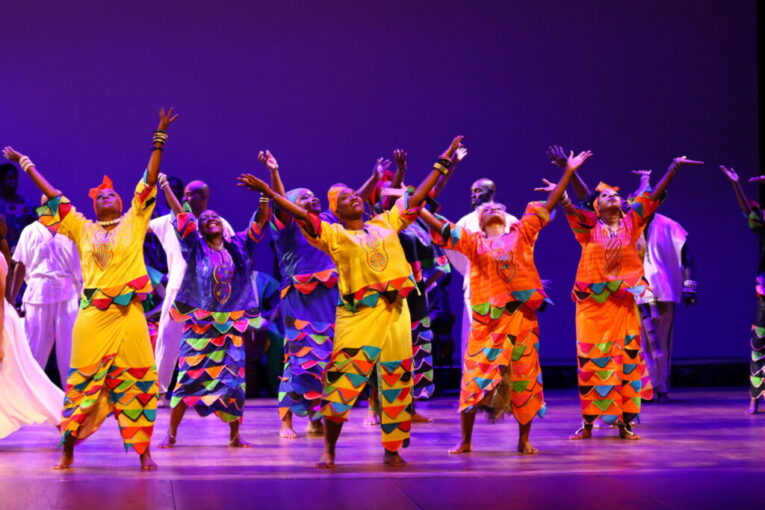
It has been a journey in glory. For 42 years, KanKouran has been providing a wide range of services and programs to the greater Washington, D.C. area. During that time, KanKouran has offered 12,500 classes for 800,000 participants, performed 180 major concert productions for 270,000 audience participants, hosted 40 dance conferences serving 180,000 participants, performed 28,000 school shows for 11,200,000 D.C. area school students, performed 26,000 stage-performances for 12,500,000 audience participants, conducted 5,400 dance workshops for 2,800,000 participants, and conducted 5,800 school residencies for 190,000 D.C. area school students.
Thanks to its all-inclusive nature, KanKouran appeals to a wide range of audiences of various ages, races, and socio-economic backgrounds. The company’s outstanding reputation has spawned numerous collaborations with organizations and institutions throughout the U.S. and abroad.
On the local and national levels, these include: The John F. Kennedy Center for the Performing Arts, Smithsonian Institution, National Symphony Orchestra, Lincoln Center, Brooklyn Academy of Music, California Center for the Arts, Howard University, Model Secondary School for the Arts at Gallaudet University, American University, George Mason University, University of Pittsburgh, and Virginia Technical Institute.
On the international level: Silesian Dance Theater and the Dance Festival Krakow in Poland; Maui Dance Council, Hawaii; Japan Cultural Arts Center, Tokyo; the Island Center for the Performing Arts, St. Croix; as well as the Emancipation Day Committee of Trinidad and Tobago.
KanKouran is unique in that all the company’s dancers and drummers are currently from the U.S. and the Caribbean. Therefore, it is an honor and a true testament to KanKouran’s stage presence, professionalism, and artistic accuracy when the company is invited to national and international events to represent Africa.
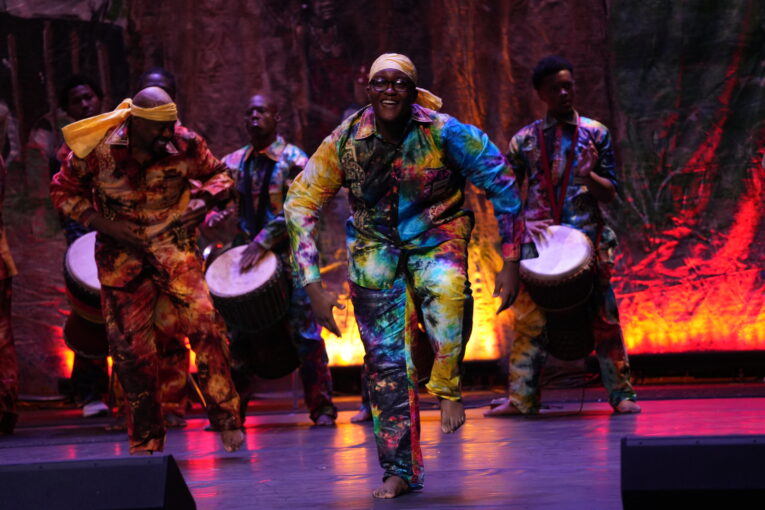
Yes, KanKouran offers a drum-based music show with agile dancers performing high-energy dances with rhythmic kicks and stomping that marvel audiences everywhere they perform. But this is more than a dance show.
KanKouran’s co-founder and artistic director, Assane Konte says, “What we do is take our tradition and put it in theater. It’s like a musical theater. It tells history.” Konte, an amazing dancer himself, also says that education is a key requirement to join the company. Referring to the company’s members, he says: “Some of them got their doctorate, some of them are school principals, some of them have their masters.” He points out that in commemoration of the company’s 40th anniversary, “they set up a scholarship for education, because most of them know me for fighting for education for the kids.”
Indeed, KanKouran is an intricate vehicle that literally educates the American public about African culture and history through the art of drumming and dancing to facilitate cross-cultural enrichment. Quite telling, the first performance of the D.C. community-based company took place in a local school, Logan Community School, in 1984, with its full-length concert, aptly titled “A visit to Africa,” taking place at George Washington University the following year.
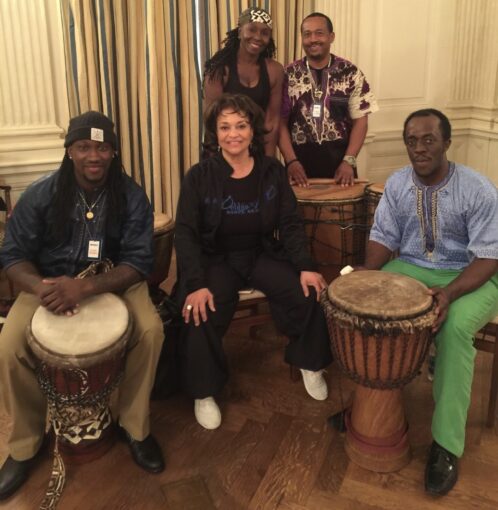
Driven by its educational mission, KanKouran gives dance classes on a regular basis in its own facility in Takoma Park, Maryland, near D.C. But the company’s reputation grew so big and so fast that some of the finest performing arts institutions the United States, including the renowned, majestic John F. Kennedy Center for the Performing Arts, host dance classes and workshops curated by KanKouran’s instructors.
As recently as earlier this year, in a class held in three sessions in February at the Kennedy Center, KanKouran West African Dance Company presented “Visit Africa,” a class series that introduce participants to traditional West African dances from Mali, Senegal, and Guinea. Each class provided a cultural explanation of the dance and its meaning, a careful breakdown of the movements, and the opportunity to execute the dance to live drums.
The free classes focused on three types of dances:
- Doundounba
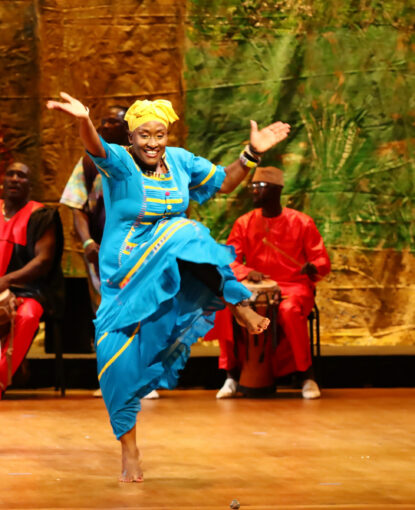
Originating in Hamana in the Kouroussa region of upper Guinea, Doundounba is a very acrobatic dance. The dancers are called Barati or masters of Bara. The Bara is the public place where the Doundounba is danced. This is where the dancers show the important people of the village their vitality and bravery. Men and women participate in the Doundounba with their own specific movements.
The class was instructed by Nzinga Tull, a D.C.-born African American senior dancer with the company. Nzinga began studying dance at age 3 in her hometown, Washington, D.C., with African Heritage Dancers and Drummers. She resumed her dance studies in Atlanta as a Spelman College student by studying with Torkwase Osahene and performing with Ayolowa, the student company of Barefoot Ballet. In 1999, she began performing with KanKouran West African Dance Company and today she is one of the company’s principal dancers.
- Yankadi/Macru
Originating from the Susu people of Guniea, this is a traditional courting dance rooted in eye contact and face-to-face movements when done traditionally. Yankadi/Macru is a two-part dance where Yankadi is slower in nature and Macru is more upbeat. The dances utilize hip movements and large arm movements to show your value when entering a family.
The class was instructed by Amachiyana Payton. A D.C. native, Payton started training with KanKouran West African Dance Company’s Founder and Artistic Director, Assane Konte, when she was 4 years old. With her huge potential, she quickly progressed into being a member of KanKouran’s children’s company, where she continued to train for the next 10 years in the various dance styles from Mali, Senegal, and Guinea.
- Dansa
This is a very popular dance originating from the Kayes region in Mali. It is performed for most celebrations, such as weddings, baptisms, naming ceremonies, and harvest celebrations. The class was taught by none other than the founder/artistic director himself, Assane Konte, fondly called Papa Assane.
KanKouran’s influence in American culture is evidenced by its historical performance at the White House on April 25, 2007, and the respect the company has earned from America’s finest artistic institutions. Not the least, as a melting pot of dancers of African and Caribbean roots and African Americans, KanKouran has also contributed significantly to connecting the American wing of the large African family to their cultural roots. Case in point, KanKouran’s senior dancer and instructor Amachiyana Payton—discussed earlier—says she has established her cultural identity, strengthened her self-esteem, and experienced personal growth in many different areas of her life, crediting her time in KanKouran with making her into the person, dancer, and artist she is today.
The appreciation of non-Blacks for KanKouran’s shows—with some of them taking the company’s classes—speaks volumes about the crucial role KanKouran plays by using the universal language of music and dance to promote diversity and inclusion in the nation.t
Kankouran’s co-founder Abdou Kounta who served as the company’s first musical director until 1992, transitioned on January 24, 2011, at his Columbus, Ohio residence. The seed he jointly planted 42 years ago with his friend Assane has grown into a cultural baobab tree with roots deeper and shade wider than they probably imagined back then.
Abdou had a gift for drumming from an early age, although he was not from a griot family. He started drumming under the tutelage of the legendary djembe master Dugufana around the age of 13. As he grew older, he drummed with many different companies in Senegal and became very well known for his talent and impressive skills. He began traveling extensively when he joined the National Ballet of Senegal. After a tour with the National Ballet to the U.S., Abdou returned to Senegal and decided he wanted to move to the U.S. and work with some of the people he met during the Ballet’s tour. Abdou is credited with laying the foundation for playing djembe in the Washington, D.C. area. He taught countless students, while also performing with African Heritage, Wo’se, Koumpo, and several other dance companies.
After relocating to Columbus, Ohio in 1997, he co-founded Thiossane West African Dance Institute in 2000 with his wife. His artistic skills continued to be requested in Japan, as well as with several symphony orchestras throughout the United States.
A beautiful line in his obituary posted on the website of Diehl Whitakker Funeral Cremation Services reads: “His mastery skills will continue to echo rhythms throughout the lives of family, friends, and students for generations to come.”
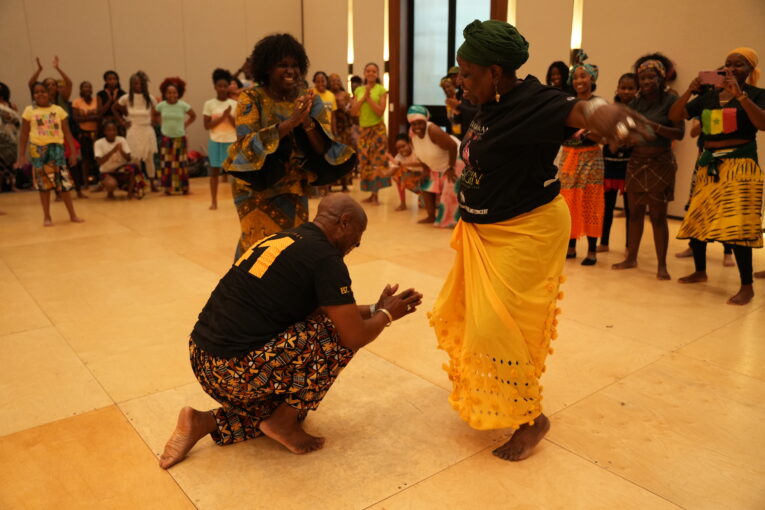
As Kankouran’s artistic director since the company’s inception in 1983, Assane Konte serves as choreographer and costume designer. Assane began his dance training at age 12. His career as a professional dancer began at age 15 with “Ballet Africain de Diebel Guee” of Dakar, Senegal. During his ten years with the company, he electrified audiences with his highly energetic performances, while simultaneously developing his own unique movement style.
Assane’s lifelong dedication to preserving and sharing Africa’s rich culture through dance and music in America has made him a goodwill ambassador, promoting cross-cultural appreciation and understanding in the many performance venues in which he and the company have appeared.
For his tireless work, innovative choreography, and outstanding contribution to the arts, Assane has been the recipient of several prestigious arts awards, in addition to many Outstanding Community Service Awards.
Through his careful and meticulous choreography, Assane has taken U.S.-based African dance to its highest level. Simultaneously, he has challenged his company’s dancers and drummers to achieve impressive levels of virtuosity and technical ability. Assane’s ingenious creativity and master choreography is always in demand at home and abroad. Consequently, he is invited to teach at annual events in Poland, Hawaii, Japan, and St. Croix. He conducts specialized dance workshops at conferences around the world and has held positions in the dance departments at the American University, Georgetown University, and George Mason University. He presently serves on the faculty of the Dance Department at Howard University.
In an article published in the August 31, 2011, edition of The Washington Post in reference to Assane’s performance, reporter DeNeen L. Brown writes: “Assane Konte, artistic director of KanKouran West African Dance Company, stomps in naked feet. He stretches his arms as if he were a bird with lovely and powerful long wings. The drums beat faster and faster. Konte’s body moves as though on fire, quickly and strongly, graceful and yet intense. It is as if he and the drums are connected.”
Trailblazers like Abdou Kounta and Assane Konte live forever.
Many dancers and drummers have come and gone over the years, and KanKouran’s reputation as the premier West African Dance Company rests on the shoulders of all those who have given—and are still giving—their time, sweat, energy, and support to this organization. One should hope that KanKouran will remain committed to artistic excellence in all its performances, presentations, classes, workshops, residences, and outreach efforts for centuries to come.
TO LEARN MORE ABOUT THE KANKOURAN WEST AFRICAN DANCE COMPANY, VISIT www.kankouran.org

